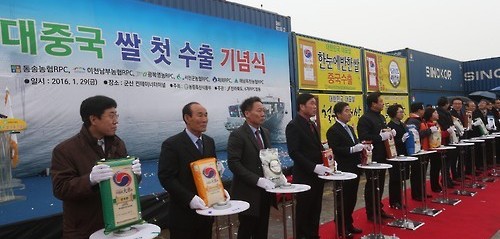- California Assembly OKs highest minimum wage in nation
- S. Korea unveils first graphic cigarette warnings
- US joins with South Korea, Japan in bid to deter North Korea
- LPGA golfer Chun In-gee finally back in action
- S. Korea won’t be top seed in final World Cup qualification round
- US men’s soccer misses 2nd straight Olympics
- US back on track in qualifying with 4-0 win over Guatemala
- High-intensity workout injuries spawn cottage industry
- CDC expands range of Zika mosquitoes into parts of Northeast
- Who knew? ‘The Walking Dead’ is helping families connect
S. Korea to export rice to China for first time in Feb.

Government officials attend a ceremony at a port in Gunsan, southwest of Seoul, on Jan. 29, 2016, for the first rice export to China. The first shipment of 30 tons will leave the port next month for Shanghai, where they will be marketed at Lotte Market outlets. South Korea has been working for the last seven years to have rice exported to the neighboring country, hindered by quarantine requirements. (Yonhap)
SEJONG (Yonhap) — South Korea plans to export rice to China for the first time in February after both sides agreed on a set of quarantine requirements last year, the farm ministry said Friday.
According to the ministry, 30 tons of rice will be loaded onto containers at Gunsan port on the west coast later Friday, which will leave in early February and arrive in Shanghai in mid-February for customs procedures.
After clearing Chinese customs, the Korean rice will be marketed at 69 outlets of the Shanghai Lotte Market. The ministry plans to hold promotional events between late February and early March.
The ministry said it plans to ship an additional 70 tons of rice to China in the middle of next month through Korea’s Daewoo International Corp. and the China National Cereals, Oils and Foodstuffs Corp.
The rice exports come seven years after South Korea first requested that China allow them. Exports had been blocked by China’s tough quarantine requirements, but Seoul and Beijing agreed on new terms following the South Korea-China summit talks in October last year.
The ministry said South Korea hopes to export a total of 2,000 tons of rice this year.
Agriculture Minister Lee Dong-phil said entering the Chinese market will be an opportunity for Korea’s rice exports amid continued imbalance in supply and demand of the key staple grain.
The growing excess of rice has been one of the government’s urgent tasks to resolve. The government aims to seek a balance between the supply and demand of rice by 2018 through gradual reduction in the area of rice paddies and expansion of domestic consumption and exports.
According to the ministry’s plan, the area of rice paddies should decline from 799,000 hectares this year to 711,000 hectares in 2018, a significantly smaller area than the expected 749,000 hectares of paddies that would be in service if no action is taken.
According to government data released Friday, South Korea’s per capita rice consumption fell 3.4 percent on-year to a record low of 62.9 kilograms last year as people added other types of grain products to their diet.















